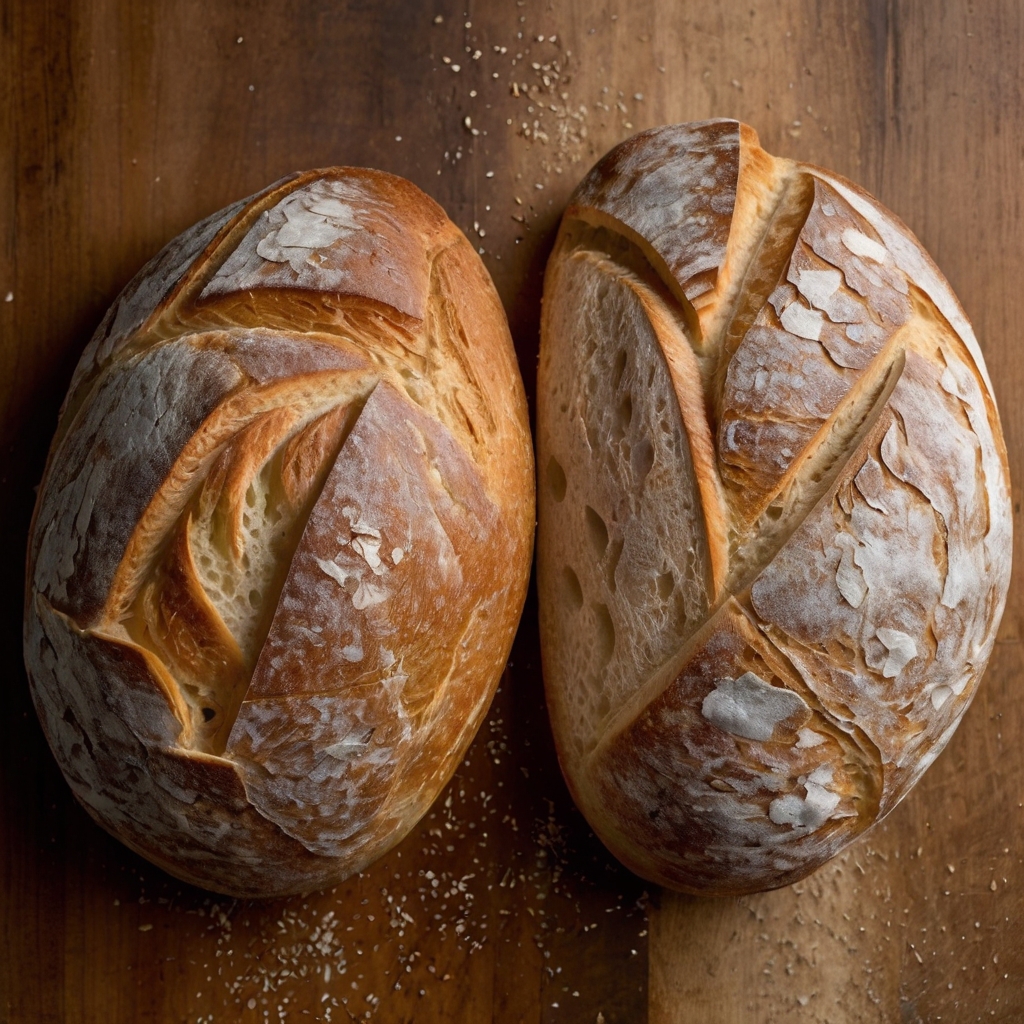How Long Can Sourdough Proof in the Fridge
How long can sourdough proof in the fridge? Cold proofing gives bakers amazing flexibility. You can let the dough ferment anywhere from 5 hours to 48 hours. This extended time makes sourdough baking fit easily into busy schedules and different lifestyles.
The dough develops a thin skin in the fridge that makes it easier to handle and score before baking. Most bakers let their sourdough proof at cold temperatures between 8 to 16 hours, based on their fridge temperature. The dough can stay in the fridge up to 36 hours while keeping its excellent quality. Some expert bakers have successfully left their loaves in the refrigerator for 3 days. The quality starts to decline after the third day.
This piece covers everything you need to know about proofing sourdough in the refrigerator. You’ll learn the ideal timeframes and how to tell when your dough is perfectly proofed and ready to bake.

What is sourdough proofing and why it matters
Sourdough proofing plays a crucial role in bread-making that affects the quality, texture, and flavor of your final loaf. Proofing is the final fermentation period between shaping your dough and baking it in the oven. The yeast cells eat carbohydrates and release carbon dioxide gas during this time, which makes the dough expand and create its airy structure.
Your bread needs proper proofing. Without it, the yeast can’t release enough carbon dioxide, and the gluten network won’t stretch enough to trap those air bubbles. So bread that skips proofing will lack volume, texture, and flavor. It also gives your sourdough that signature tangy taste and helps create that crispy crust everyone loves.
Understanding the second rise
Bakers call proofing the second rise, which starts after you’ve shaped your dough into its final form. Your dough has built structure through previous fermentation but needs more time to develop flavor and reach the right volume.
Something interesting happens when you proof sourdough in the refrigerator. The cold makes the yeast mostly dormant and slows their activity way down. The bacteria in your sourdough keep working though, slowly increasing acidity and building that distinctive tangy flavor. Bakers call this “retarding” or “cold retard” because it slows down the rising process on purpose.
The time you spend proofing affects your bread’s character by a lot. Your sourdough can proof in the fridge anywhere from 12 to 48 hours. The longer it proofs, the more acidic and sour it becomes as bacteria keep working. To name just one example, many bakers find that 14-18 hours of cold proofing creates excellent flavor without risking overproofing.
You’ll know your dough is proofed right when you see:
- More size (but not always doubled)
- Bubbles just under the surface
- A smooth, almost shiny surface
- A domed shape showing remaining strength
Difference between bulk fermentation and proofing
New bakers might mix up bulk fermentation with proofing, but each serves its own purpose in sourdough bread making. Bulk fermentation comes first and represents your dough’s initial rise.
Room temperature bulk fermentation usually takes 5-8 hours. Your dough ferments as one large mass during this phase (that’s why it’s called “bulk”), and this is where most yeast activity and gluten development happens. You’ll often stretch and fold the dough to build strength and structure.
Proofing happens later, after you’ve shaped your dough into its final form. The main goal changes from building structure to boosting flavor and achieving final volume. This final rise creates much of your bread’s character.
Dough that gets too warm during bulk fermentation will make yeast work faster than gluten can develop. Air bubbles might collapse and leave you with a dense loaf. On the flip side, proofing too long, especially at room temperature, risks overproofing that can result in a flat, dense loaf with poor oven spring.
Cold proofing in the fridge does more than develop flavor. It makes dough easier to handle when you move it to baking vessels and gives you better control over timing. Many artisan bakers swear by cold fermentation as a great way to get complex flavors and achieve perfect crumb structure.
How long can sourdough proof in the fridge?
Cold proofing sourdough gives bakers more control over their baking schedule. The refrigeration slows down fermentation and lets you bake when it suits you rather than when the dough demands it.
Typical cold proofing durations
The best results come from cold proofing sourdough between 12 to 48 hours. This longer timeframe lets flavors develop fully while keeping the dough structure intact.
You need at least 2 hours of cold proofing to improve handling and scoring, but this won’t do much for flavor. The dough needs at least 12 hours in the fridge to let beneficial fermentation work its magic.
Most home bakers put their shaped dough in the fridge for 10 to 16 hours overnight and bake it first thing in the morning. Professional bakers follow similar schedules because it balances convenience and quality.
Many sourdough enthusiasts think 12-36 hours of cold proofing hits the sweet spot. This timeframe creates complex flavors, lighter crumb, and makes the bread easier to digest without breaking down the dough structure.
Maximum time before overproofing
Your sourdough should stay good in the fridge for up to 3 days (72 hours). The dough might overproof after this point, which could leave you with flat, dense loaves that won’t spring up in the oven.
Your cold-proofed dough has gone too far if you notice:
- A sticky texture that’s hard to handle
- Dough that won’t hold its shape
- No elasticity left
- A smell that’s too sour or off
The dough’s gluten starts breaking down after about 96 hours (4 days). One baker’s dough showed clear signs of overproofing at 115 hours. Another baker saw their dough completely break down after 5 days.
What happens after 24, 36, and 48 hours
Cold-proofed sourdough changes in predictable ways over time:
After 24 hours: Flavors start developing but haven’t reached their peak. One baker found large air pockets in their bread but missed the depth and complexity that comes with longer proofing.
After 36 hours: This sweet spot brings rich flavors while keeping good structure. Many bakers call this the perfect balance between convenience and quality.
After 48+ hours: The bread develops a stronger sour taste and more complex flavors. One baker’s 48-hour loaf turned out “lighter and airier” with “a more pleasing mildly sour taste” compared to the 24-hour version. They also got better oven spring and scoring results.
The science shows that lactic acid bacteria stay active in cold temperatures even when yeast slows down. These bacteria create acetic acid (basically vinegar) that gives sourdough its signature tang. The long fermentation also makes nutrients more available and the bread easier to digest.
Your fridge’s temperature plays a vital role in cold proofing. Most home refrigerators stay around 39°F (4°C), which slows fermentation but doesn’t stop it. If your dough overproofs too quickly, dropping the temperature a degree or two can help extend proofing time.
The right cold proofing time depends on how sour you like your bread, what fits your schedule, and your starter’s unique characteristics.

Factors that affect fridge proofing time
Several variables determine the success of sourdough proofing in the refrigerator. Bakers can adjust their processes and achieve consistent results by understanding these factors, whatever their kitchen conditions or recipe variations.
Fridge temperature and airflow
Your sourdough needs a temperature between 39°F and 45°F (4°C-7°C) for cold proofing. This range slows down yeast activity while beneficial bacteria continue to develop flavor. Small temperature changes can affect proofing time substantially.
“Cold slows it down” isn’t just baker’s wisdom—it’s scientifically accurate. A refrigerator at 39°F (4°C) extends proofing time compared to one at 45°F (7°C). Professional bakers suggest keeping temperatures above 39°F (4°C) to maintain proper fermentation.
Your refrigerator’s airflow system is another vital factor. Dough surfaces can dry out too much in refrigerators with circulating fans, which creates problems during baking. One baker’s uncovered dough in a fan-circulation fridge “loses a lot of moisture which negatively affects the oven spring and leaves the final loaf looking constrained”.
Flour type and hydration level
Cold proofing affects different flour compositions uniquely. “May not cope as well with cold proofing as bread flour” applies to whole grain and rye flours. These flours develop a weaker gluten network that breaks down easier during extended refrigeration.
The ratio of water to flour—hydration level—shapes cold proofing behavior. Doughs with higher hydration (above 70%) ferment faster than drier ones and become unstable above 85°F (29°C). High-hydration sourdough becomes “easier to handle” when scoring and moving to baking vessels with cold proofing.
Dough strength and shaping tightness
Dough handling characteristics change with refrigeration. Bakers notice their dough feels “rougher than pre-refrigeration, as if it’s got less strength to hold air” after cold storage. This effect intensifies with longer refrigeration times.
Dough performance during cold proofing depends on shaping tension. Cold dough makes building surface tension challenging. One baker struggled because “the dough did not grab onto the counter as when shaping with room temp dough”.
Expert bakers recommend these solutions:
- Warm your dough for about an hour before shaping to develop better tension
- Your starter percentage should match ambient temperature (use more in colder weather)
- Your kitchen’s warmth affects fermentation timelines (warmer spaces speed up fermentation)
These variables help you turn cold proofing from guesswork into a predictable process. You can adjust proofing duration confidently based on your conditions.
Should you cover sourdough while proofing in the fridge?
Bakers often debate whether they should cover their sourdough during refrigerator proofing. This choice depends more on your refrigerator’s conditions than any universal rule.
When to cover and why
Cold proofing requires protection from moisture loss. Most modern refrigerators use forced air systems that can dry out exposed dough surfaces. A dried surface can limit your oven spring and give you a tight loaf with a tough crust. Your dough’s overall hydration drops as the surface dries out, which makes it harder for the bread to expand properly during baking.
You don’t always need to cover your dough. Your decision should depend on:
- Your refrigerator’s air circulation
- Your dough’s hydration level
- The type of crust you want
- Your proofing duration
Best materials to use
You have several great options to cover your dough:
- Plastic shower caps fit perfectly around banneton baskets and lock in moisture. These create an ideal environment for your dough and you can reuse them.
- Plastic bags make excellent covers. Just put your banneton inside, fold the bag over, and tuck it under the basket to seal the environment.
- Linen liners strike a balance. They shield from drafts while letting some air circulate.
- Reusable plastic wraps adapt well to different container shapes and sizes.
Uncovered proofing: when it works
Many skilled bakers leave their dough uncovered during cold proofing. This technique creates a thin, dry skin on the dough surface that has several benefits:
- The dough sticks less to peels or baking surfaces
- Scoring and shaping become easier
- The dry part becomes the loaf’s bottom, making texture differences hard to spot after baking
This method works best in refrigerators with gentle air circulation and with doughs that have enough moisture to handle some surface drying.
How to tell if your sourdough is ready to bake
Baking refrigerated sourdough at the right moment needs a good eye and hands-on assessment. Your dough’s readiness becomes crucial after it proofs in the fridge. A perfect artisan loaf depends on this timing.
Visual signs of readiness
Well-proofed sourdough shows several clear signs. The dough grows about 50-75% in size rather than doubling completely. Small bubbles start appearing beneath or on the surface that indicates active fermentation. The dough’s surface becomes smooth with a slight dome shape, showing it has enough strength to bake.
Time becomes your main indicator with refrigerated dough. Most sourdough loaves reach their sweet spot after 10 hours of cold proofing. The dough stays good up to 24 hours without major problems.
The poke test explained
The poke test gives you reliable feedback about your dough’s fermentation. Here’s how to do it:
- Lightly dust your finger with flour
- Gently press about half an inch into the dough
- Observe how it responds
The results tell different stories:
- Underproofed: Indentation bounces back fast and fully
- Properly proofed: Indentation comes back halfway slowly
- Overproofed: Indentation stays and doesn’t recover
Notwithstanding that, this test works nowhere near as well with cold dough fresh from the fridge. Cold dough feels naturally stiffer and reacts differently to poking. It often springs back quickly even when it’s properly proofed.
Handling cold dough for scoring and baking
Cold dough gives you clear advantages in the final steps. Scoring becomes much easier with refrigerated dough because it holds its shape better during banneton transfer. The blade cuts through cold dough cleanly and creates precise patterns that open beautifully while baking.
Expert bakers recommend putting sourdough straight from fridge to oven without warming. This method keeps the dough firm and prevents collapse after scoring. Moving the dough to your preheated oven right after scoring preserves its structure and helps maximize oven spring.
Summing it all up
Cold proofing sourdough bread turns a strict timeline into a flexible schedule that fits busy lives. The refrigeration process lets you extend the fermentation window from 5 to 48 hours without losing quality. Many bakers get the best results between 12-36 hours. This time range strikes the right balance between convenience and flavor development.
The refrigerated proofing method brings several practical benefits. The cold dough becomes much easier to handle and score, which creates beautiful expansion patterns during baking. The extended cold fermentation also builds deeper flavor complexity. Your bread becomes more digestible as beneficial bacteria keep working at low temperatures.
The success of cold proofing relies on several elements. Your fridge’s temperature, the type of flour you use, hydration levels, and shaping technique all play vital roles in determining the ideal proofing time. You’ll need to experiment to find what works best in your kitchen.
You can choose to cover your dough or leave it exposed based on your fridge’s airflow system and what you prefer. Both methods work well when they match your specific situation.
Cold proofing is forgiving by nature. Unlike room-temperature dough that needs precise timing, refrigerated sourdough gives you amazing flexibility. This adaptability makes artisan bread baking available to people with unpredictable schedules. The techniques in this piece help bakers naturally incorporate cold proofing into their sourdough routine. They can achieve professional-quality results while fitting baking into their daily lives.
Here are some FAQs about how long can sourdough proof in the fridge:
Can sourdough proof too long in the fridge?
Yes, sourdough can overproof in the fridge if left too long (how long can sourdough proof in the fridge). Typically, 12-48 hours is ideal, but beyond 72 hours may lead to overfermentation (how long can you proof sourdough in the fridge). Signs include a collapsed structure, sour smell, and sticky dough that won’t hold shape (how long can my sourdough proof in the fridge).
How long can you let dough rise in the fridge?
Sourdough can safely proof in the fridge for 12-72 hours depending on recipe and temperature (how long can i proof sourdough in the fridge). Most bakers find 24-36 hours produces the best flavor and texture balance (how long can a sourdough loaf proof in the fridge). The colder your fridge, the longer the proofing window (how long can sourdough proof in the fridge).
What is the maximum time for cold proofing sourdough?
The absolute maximum is about 3-4 days in a very cold fridge (34-38°F) (how long can you proof sourdough in the fridge). Beyond this, gluten breaks down too much and the dough becomes unworkable (how long can my sourdough proof in the fridge). For most home fridges, 48 hours is the practical limit before quality declines (how long can a sourdough loaf proof in the fridge).
Can you leave bread proofing too long?
Yes, overproofing occurs when fermentation continues too long (how long can i proof sourdough in the fridge). The dough becomes weak, loses elasticity, and may collapse when baked (how long can sourdough proof in the fridge). Both bulk fermentation and final proof can be overdone, especially in warmer conditions (how long can you proof sourdough in the fridge).
Can you save overproofed sourdough?
Mildly overproofed dough can sometimes be rescued by reshaping and giving a shorter second proof (how long can my sourdough proof in the fridge). Severely overproofed dough may be usable for flatbreads or crackers but won’t make good loaves (how long can a sourdough loaf proof in the fridge). Adding a small amount of fresh flour can sometimes help revive it (how long can i proof sourdough in the fridge).
What happens if I let my sourdough rise too long?
Overproofed sourdough develops large air pockets that collapse, resulting in dense bread (how long can sourdough proof in the fridge). The gluten structure weakens, causing flat loaves with poor oven spring (how long can you proof sourdough in the fridge). Excess fermentation also creates an unpleasantly sour taste and gummy texture (how long can my sourdough proof in the fridge).
How do you know when sourdough is done proofing?
Properly proofed sourdough springs back slowly when poked, leaving a slight indent (how long can a sourdough loaf proof in the fridge). The dough should look puffy with visible bubbles just under the surface (how long can i proof sourdough in the fridge). In the fridge, it typically doubles in size more slowly than at room temperature (how long can sourdough proof in the fridge).
How to tell if dough has gone bad?
Bad dough develops an off smell (sour milk or alcohol), grayish color, or mold spots (how long can you proof sourdough in the fridge). If the surface appears slimy or develops an unusual texture, it should be discarded (how long can my sourdough proof in the fridge). Healthy sourdough smells pleasantly tangy, not rotten (how long can a sourdough loaf proof in the fridge).




